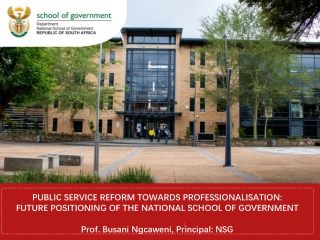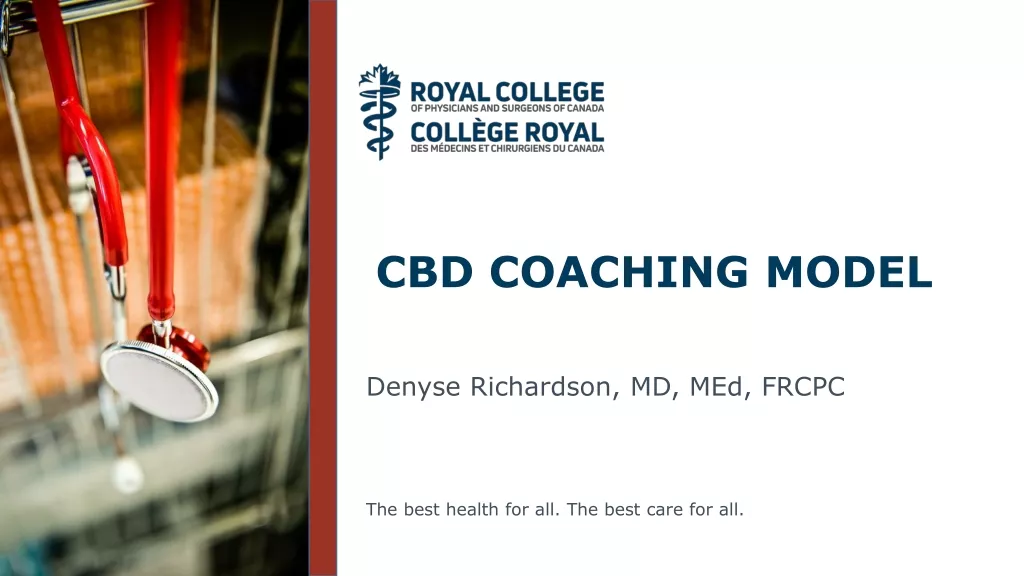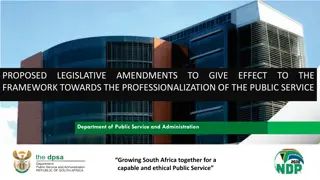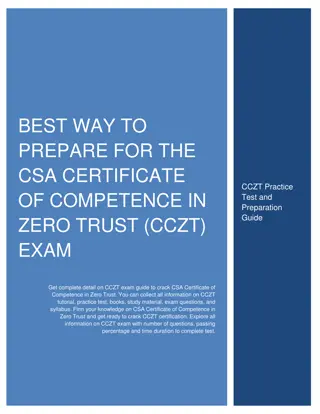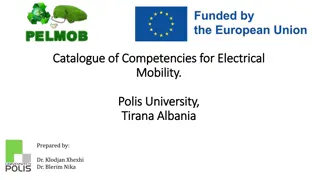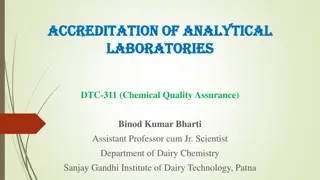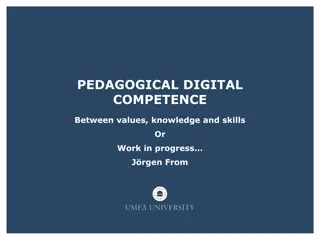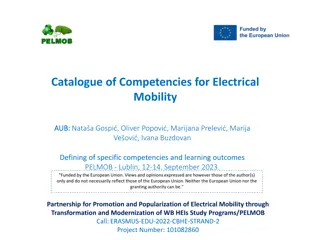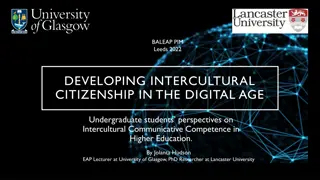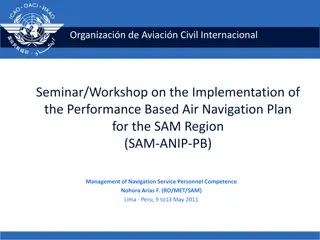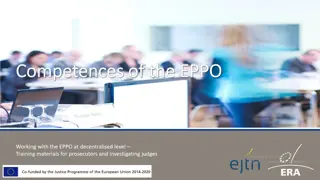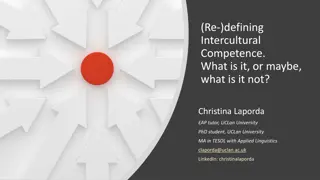Exploring Competence Models and Professionalization in Teaching: Perspectives and Challenges
Unpacking the essence of a good teacher, this workshop delves into competence models, professionalization concepts, and conflicts of interest in teaching. It contrasts competence-based and holistic approaches in teacher education, discussing tensions between complexity in teaching and the need for a common practice framework. Various models of the ideal teacher are critiqued, including the craftsperson, reflective practitioner, charismatic subject, and transformative intellectual. The discourse emphasizes the importance of critical reflection and problematizing assessment methods in teaching.
Download Presentation

Please find below an Image/Link to download the presentation.
The content on the website is provided AS IS for your information and personal use only. It may not be sold, licensed, or shared on other websites without obtaining consent from the author. Download presentation by click this link. If you encounter any issues during the download, it is possible that the publisher has removed the file from their server.
E N D
Presentation Transcript
Essen Conference Workshop: What makes a good teacher? Competence models, concepts of professionalisation, and conflicts of interest. David Stevens, Durham University School of Education.
The Competence-based model of teacher education in the UK. Competence-based approaches may be seen as atomistic, superficial, attempting to make the complex simple to assess, reductive, decontextualised. Essentially, competence approaches could be seen as inevitably reductive, therefore, with the focus on mechanical performances or actions, without taking note of the importance of understanding (Fleming). Schools make little place for reflectivity. Once teachers internalise the routines and learn the content they are to teach [a very limited model of subject knowledge, surely] their ability to cope is assured and with it the need to grow as teachers diminishes . (Eisner 1998: 115.)
Opposing (usually European) more holistic models of competence-based teacher education. Historically the competence model in Europe developed in opposition to a traditional knowledge-based curriculum in favour of acknowledgement of skills and positive achievements: the valuing what people can do approach. OECD (2005), quoted by Fleming, competence defined as the means to meet complex demands in a particular context .
The tensions between the many complexities involved in teaching / the need for a generally understood framework for development of good practice. Goudie (1999, in Moore, 2000: 127) takes the argument further: Deference to any prescriptive theory is out of pace with time and contexts and suppresses consciousness of the self as a social being; it results in conformity, and disempowers social actors from acting authentically in response to the particular situation. It also turns practice into a technical performance, debilitating the creative imagination as it interacts with external reality . Thus the need to problematise approaches to assessment of teaching, taking into account the two very different traditions.
Diverse models of the good teacher: a critical overview. The competent craftsperson: a training-based model, with emphasis on apprenticeship relationships to experienced teachers, classroom management techniques, efficient delivery of an accepted curriculum, transparent accountability. The reflective practitioner, engaged in critical reflection upon the nature of the individual s teaching in any given context or situation through sensitive mentoring and evaluation of success / failure in the classroom. The charismatic subject, given immense credibility through subjective experience of schooling by both teachers and learners, but with the unfortunate corollary that good teachers tend to be born rather than made . The transformative intellectual (Giroux) engaged in the pedagogy of discomfort (Boler) in taking the reflexive turn (Moore) towards full critical acknowledgement of both particular and broader contexts for teaching and learning, and a larger vision and realisation of human freedom (Giroux).
The last of these models endorses what is essentially a species of critical pedagogy, as developed by Freire and followers (including Giroux). It may also be termed a formation model, attempting to integrate critical theory with engaged practice towards an Aristotelian sense of phronesis: practical judgement , or praxis. Freire elaborates: Knowledge begins with the awareness of knowing little Human beings constantly create and re-create their knowledge, in that they are inconclusive, historical beings engaged in a permanent act of discovery . (Freire 2005: 107.)
Possible ways forward. A fuller sense of reflexivity in the sense that Moore has explored this term, emerges through visualising the development of teaching holistically, in a much bigger picture: a picture that may be the practitioner s own history, dispositions, prejudices and fears, as well as the wider social, historical and cultural contexts in which schooling itself is situated. In other words, within reflexivity, that which is being evaluated or reflected upon is not treated as if it were the whole of the picture, but is made sense of by reference to what is happening in the rest of the larger picture .(Moore 2004: 149.)
while both the competences and the reflective practitioner discourses may be of use to the teacher, it may be the reflexive discourse that fully activates that usefulness, making it accessible and opening the way to a more critical engagement with the interface between personally-experienced difficulties and systemic failings (Moore 2000: 138) Freire himself starts from the perspective of problematisation in teaching and learning, as opposed to simply gaining competence confidently, if superficially. In the process of problematisation, a step made by a Subject [ie teacher or student, or of course student-teacher] to penetrate the problem-situation continually opens up new roads for other Subjects to comprehend the object being analyzed. Educators who are problematised by engaging in this kind of action re-enter into the object of the problem through the entering into of the educatees. This is why educators continue to learn. The humbler they are in this process the more they will learn . (Freire 2005: 135.)
References. Carr, D (2003) Making Sense of Education London: Routledge Falmer. Eisner, E. (1998) The Enlightened Eye. New Jersey: Prentice Hall. Fleming, M (2009) The Challenge of Competence inHu, A. and Byram, M. (eds) Intercultural Competence and Foreign Language Learning. Tubingen: Gunter Narr Verlag. Freire, P. (2005). Education for Critical Consciousness. London: Continuum. Giroux, P. (2001). Theory and Resistance in Education: Towards a Pedagogy for the Opposition. Westport (USA): Bergin & Garvey. Goodson, I. (2005) Learning, Curriculum and Life Politics London: Routledge. Moore, A. (2004). The Good Teacher. Abingdon: Routledge. Moore, A. (2000). Teaching and Learning: Pedagogy, Curriculum and Culture. London: RoutledgeFalmer. Stevens, D. (2010) A Freirean critique of the competence model of teacher education, focusing on the standards for qualified teacher status in England in The Journal of Education for Teaching, vol 36, no 2, p187-196.


